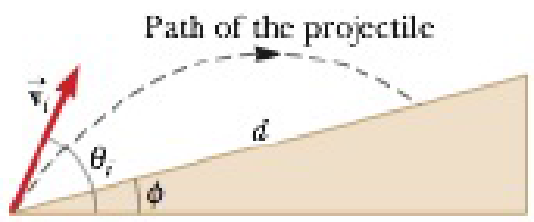
Concept explainers
A projectile is fired up an incline (incline angle ϕ) with an initial speed vi at an angle θi with respect to the horizontal (θi > ϕ) as shown in Figure P4.50. (a) Show that the projectile travels a distance d up the incline, where
(b) For what value of 0i is d a maximum, and what is that maximum value?
Figure P4.50

Trending nowThis is a popular solution!

Chapter 4 Solutions
Bundle: Physics For Scientists And Engineers With Modern Physics, 10th + Webassign Printed Access Card For Serway/jewett's Physics For Scientists And Engineers, 10th, Multi-term
- A firefighter, a distance d from a burning building, directs a stream of water from a fire hose at angle i above the horizontal as shown in Figure P3.16. If the initial speed of the stream is vi, at what height h does the water strike the building? Figure P3.16arrow_forwardOlympus Mons on Mars is the largest volcano in the solar system, at a height of 25 km and with a radius of 312 km. If you are standing on the summit, with what Initial velocity would you have to fire a projectile from a cannon horizontally to clear the volcano and land on the surface of Mars? Note that Mars has an acceleration of gravity of 3.7m/s2 .arrow_forwardA catapult on a cliff launches a large round rock towards a ship on the ocean below. The rock leaves the catapult from a height H of 31.0 m above sea level, directed at an angle θ above the horizontal with an unknown speed v0. What is the vertical component of the rock's velocity at its maximum height?arrow_forward
- A large cannon is fired from ground level over level ground at an angle of 300 above the horizontal. The muzzle speed is 980 m/s. Neglecting air resistance, answer the following questions: a) what is the maximum height that the projectile will reach? b) how long till the projectile will hit the ground? c) the projectile will travel what horizontal distance before striking the ground?arrow_forwardA projectile is launched from point A with speed vo = 38 m/s. Determine the value of the launch angle a which maximizes the range R indicated in the figure. Determine the corresponding value R. Vo = 38 m/s A Answers: α = α R= i i 127 m- 15.8 m R 3 Barrow_forwardA projectile is launched from point A with speed vo = 29 m/s. Determine the value of the launch angle a which maximizes the range R indicated in the figure. Determine the corresponding value R. v0 = 29 m/s A Answers: a = a R = i 64 m 20.3 m R O 3arrow_forward
- An item with beginning speed vo is projected from the edge of the roof of a structure of height H. The object's initial velocity produces an angle a0 with the horizontal. Don't think about air resistance. What is the speed of the item shortly before it hits the ground if a0 = -90 and the object is thrown straight down?arrow_forwardI know Bartleby policy, can you still answer all the questions.arrow_forwardA projectile is fired from a point 50 meter from a tall cliff at 75 m/sec and at angle of 50 degrees above the horizontal. It will strike the cliff at a point h above the cliff base. What is h? What is the final speed of the projectile when it hits the cliff in the problem above?arrow_forward
- A father demonstrates projectile motion to his children by placing a pea on his fork's handle and rapidly depressing the curved tines, launching the pea to heights above the dining room table. Suppose the pea is launched at 7.55 m/s at an angle of 71.0° above the table. With what speed (in m/s) does the pea strike the ceiling 2.10 m above the table? Find M/Sarrow_forwardImagine an archer preparing to fire an arrow. The archer aims the arrow directly ahead, that is to say, parallel with the ground. Bows are drawn to the corner of the mouth when fired. Let's say, for this particular archer, that puts the arrow 1.8 m (about 5.5 feet) above the ground. Assume that we have measured the initial speed of arrows fired by this archer with this bow and it is 100 m/s. (Ignore wind resistance) a) At what point during the arrow's flight will it be moving the fastest? (Be careful here, think about it. You don't need to do any calculations to figure this out.) b) How long will it take for the arrow to hit the ground?c) How far will the arrow travel during this time period?arrow_forwardCould I have help with this physics question?arrow_forward
 Principles of Physics: A Calculus-Based TextPhysicsISBN:9781133104261Author:Raymond A. Serway, John W. JewettPublisher:Cengage Learning
Principles of Physics: A Calculus-Based TextPhysicsISBN:9781133104261Author:Raymond A. Serway, John W. JewettPublisher:Cengage Learning University Physics Volume 1PhysicsISBN:9781938168277Author:William Moebs, Samuel J. Ling, Jeff SannyPublisher:OpenStax - Rice University
University Physics Volume 1PhysicsISBN:9781938168277Author:William Moebs, Samuel J. Ling, Jeff SannyPublisher:OpenStax - Rice University

